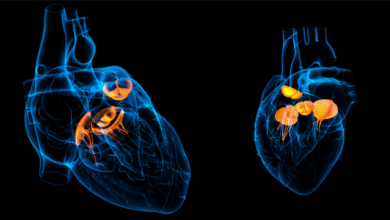Search results
Author(s):
Michael H Picard
Added:
3 years ago
Non-invasive imaging of the heart continues to evolve and improve. Cardiovascular ultrasound (echocardiography) continues to play an important role in the diagnosis and assessment of responses to therapy of many cardiac conditions. Even as the clinical applications of newer techniques such as cardiac computed tomography (CT) and cardiac magnetic resonance imaging (CMRI) increase, the role of…
View more
Author(s):
Joshua Mitchell
Added:
1 year ago
In this video we asked, Dr Joshua Mitchell, Assistant Professor of Medicine at Washington University School of Medicine and the Director of our Cardio-Oncology Centre Of Excellence, to summarise the topic of radiation induced heart disease. Dr Mitchell's clinical interests include cardiotoxicity from cancer therapy and cancer survivorship.
Discussion Points:
1. Types of Radiation Induced Heart…
View more
Author(s):
Sara C Martinez
,
Sharonne N Hayes
Added:
3 years ago
Pregnancy is a physiologic challenge, with significant hormonal, metabolic, and hemodynamic changes. Cardiac output is objectively increased by the fifth week after the last menstrual period and continues to grow by approximately 45 % by 24 weeks in the normal, singleton pregnancy. This is facilitated by elevations in heart rate and stroke volume and a decrease in systemic vascular resistance…
View more
Author(s):
Michael F Morris
,
Philip A Araoz
Added:
3 years ago
Mitral valve dysfunction is the most common cause of valvular disease in the US.1 Although echocardiography is the primary non-invasive modality for visualizing the mitral valve, advances in technology continue to allow for improved evaluation of mitral disease with magnetic resonance imaging (MRI) and computed tomography (CT).2,3 Currently, the role for MRI and CT assessment of the mitral valve…
View more
Author(s):
William E Hellenbrand
Added:
3 years ago
Interventional Techniques to Treat Congenital Heart Disease
Congenital heart disease has been traditionally treated with surgery; however, with the development of interventional cardiology, patients are now benefiting from minimally invasive techniques.
Traditionally, open-heart surgery was performed to treat congenital stenoses and perform device closures for septal defects and other vascular…
View more
Author(s):
Glenn I Fishman
,
Richard I Levin
Added:
3 years ago
Abstract
Recently, we had the opportunity to review the progress that has been made in the field of cardiovascular disease over the past century in The FASEB Journal and, based on those thoughts, in this article we predict what may transpire in this 'century of biology'. Although it is true that 'the best way to predict the future is to invent it', we gaze through the prism of modern…
View more
Principles of Pressure Measurements for Assessment of Lower-extremity Peripheral Arterial Disease
Author(s):
Marsha M Neumyer
,
Bill Bertolino
Added:
3 years ago
Article
Author(s):
Nandita S Scott
Added:
3 years ago
The US has the highest maternal mortality rate in the developed world, at an estimated 26.4 deaths per 100,000 live births. This rate is rising, although it is falling in other wealthy nations.1 Cardiovascular disease is a leading cause of maternal death, so cardiologists need to build on their knowledge and enhance their proficiency on the management of cardiovascular disease during pregnancy.2
…
View more
Author(s):
Shubhayan Sanatani
Added:
3 years ago
In children and young adults, sudden cardiac death (SCD) occurs in approximately 1-2 per 100,000 population.1,2 While the overwhelming majority of occurrences of SCD occur in the adult population and are due to ischemic heart disease, very few cases in a pediatric population are. Pediatric SCD is a relatively uncommon occurrence whose underlying etiology often remains elusive. A long list of…
View more
Pulmonary Thromboendarterectomy
Author(s):
Stuart W Jamieson
Added:
3 years ago
Article












 « First
« First